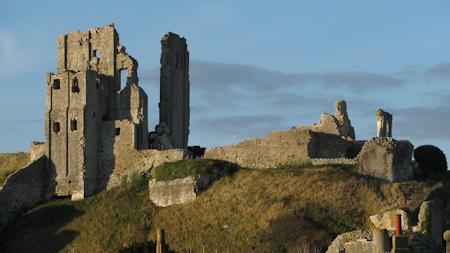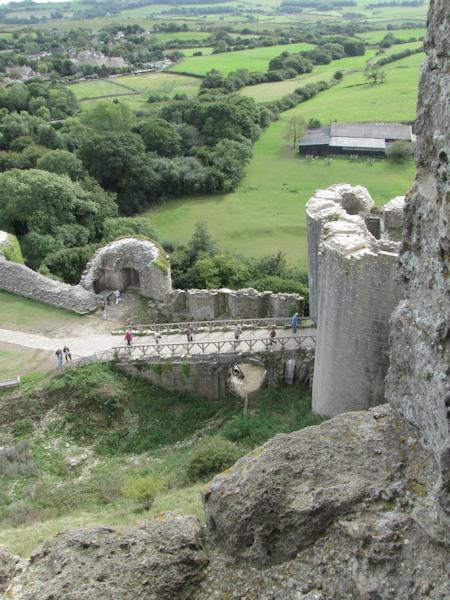
Corfe Castle
Corfe Castle stands on a naturally steep chalk hill. It commanded a pass in the Purbeck Hills on the route between the towns of Wareham and Swanage.
The construction of Corfe Castle started in the 1080s, shortly after the Norman Conquest. It was a motte castle built partially from stone. In the early 12th Century Henry I constructed the stone keep from Purbeck Limestone.
By the time of the Anarchy during King Stephen's reign Corfe was a strong fortress with stone walls and a stone keep. King Stephen unsuccessfully besieged the castle in 1169 despite building a nearby siege castle and earthworks. These earthworks can still be seen today and are a scheduled monument in their own right.
Favourite Residence of King John I
It was King John I of England who lavished attention on the castle. He spent over £1,400, a considerable sum in those days, on the walls, a deep ditch and bank and a residential gloriette with superbly appointed royal apartments. He used the castle both as a treasure storehouse and as a prison. It was one of his favourite residences.
Henry II did little more than maintain the castle, however Henry III and Edward I spent more money on it expanding the keep as well as adding defensive towers and stone curtain walls. At this point in the 13th Century it would be fair to say that Corfe Castle was one of the most powerful and finest castles in England.
Corfe remained a royal fortress until 1572 when Elizabeth I sold it. By the time of the English Civil War in 1642 it was in the hands of the Bankes family.
Civil War
In 1643 most of Dorset was under Parliamentarian control. Sir John Bankes was a supporter of King Charles I and he was in Oxford with the King while his wife and children looked after the castle.
The castle was besieged by 500 Parliamentarians. The garrison had only 5 people in the beginning, but Lady Banks was able to get food and men through the blockade and by the end of the six week siege the garrison numbered over 80. They were relieved by Royalist forces and had suffered only two casualties.
The Parliamentarians came back in 1646 under the command of Colonel Bingham. Bingham colluded with the garrison inside. A small group of soldiers pretending to be Royalists were allowed inside the castle, ostensibly to bolster the garrison. Instead they allowed the Parliamentarians in and the castle fell.
Parliament gave orders that Corfe Castle be slighted so that it could never again withstand a siege. The orders were carried out and Corfe suffered a particularly brutal demolition that lasted months. Anything that could not be blown up with gunpowder was undermined.
The Bankes family regained their properties in the 1660s, but they chose to build a new house at Kingston Lacy rather than try to rebuild their castle.
Restoration and Conservation
Corfe Castle was allowed to fall into ruin. In the 1980s Ralph Bankes gave the Bankes estate, including Corfe Castle to the National Trust. Between 2006 and 2009 they undertook extensive maintenance and conservation work to the castle buildings.
Corfe Castle was re-opened to the public in 2008 and as well as being recognised as an internationally important structure, it is one of the National Trust's most visited tourist attractions.
Facilities available at the castle include a gift shop, licensed tea room, parking and information points. There are also "Castle Quest" activity booklets, children's trails and baby changing facilities. The castle is also host to various events including walks, talks and an open air cinema in the ruins.
Status: Ruin / Visitor Attraction / Event Venue
Owner: National Trust
Tel: +44(0)1929 481 294
Email: corfecastle@nationaltrust.org.uk
Website: www.nationaltrust.org.uk/corfe-castle/
Opening Times: April to September Daily 10am to 6pm / October to March Daily 10am to 5pm


Corfe Castle Keep

Looking down at the gatehouse at Corfe